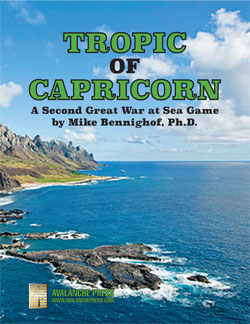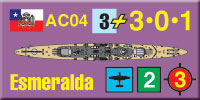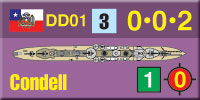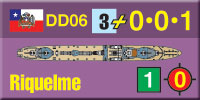Tropic of Capricorn:
Chile’s Fleet
by Mike Bennighof, Ph.D.
May 2020
 Misery acquaints a man with strange bedfellows. Misery acquaints a man with strange bedfellows.
- William Shakespeare, The Tempest
In our Second Great War alternative history story arc, once again the two great power alliances - the Allied and Central Powers - have engaged in a world-wide conflict, drawing in many other participants. Those include the South American powers of Argentina, Brazil and Chile, and that’s the theme of our Second Great War at Sea: Tropic of Capricorn game and its expansion, Tropical Storm.
The Second Great War’s South American phase begins in September 1940 with an unprovoked Argentine attack on the Brazilian fleet, a poorly-considered attempt to neutralize a potential threat to Argentina’s sea communications with her European allies. That pushes Brazil into the Central Powers camp. Chile’s close commercial ties to Britain drag her into the war along with the United Kingdom seven months later.
The Chilean fleet of the Second Great War is similar to that of the Second World War period, though like those of other nations it’s somewhat larger and built around surface ships rather than aircraft. Chile did not fight in the Second World War, but her navy had a reputation for maintaining its aging fleet core well and the United States discussed purchasing some Chilean warships in the panicked days after Pearl Harbor.
Battleships

Chile’s fleet in the world of the Second Great War is built around the pair of battleships ordered from the British shipbuilder Armstrong Whitworth in 1911 and 1912. In our own history, Almirante Latorre served the Grand Fleet as Canada. Her sister Almirante Cochrane would have borne the name India in British service but was completed as the aircraft carrier Eagle instead.
In our alternative history, Almirante Latorre is completed in October 1915 as happened historically, and she serves the Royal Navy until the end of 1916 when Wilson’s Peace brought the war to a close. Almirante Cochrane is suspended after the war’s beginning, as happened in our history, and remains in that state when the war ends (in our reality, she would not be purchased from Chile until February 1918, with serious conversion work not beginning until the hull’s launch in June of that year).
The two Chilean ships outwardly resembled the latest British super-dreadnoughts, the Iron Duke class. But they were substantially larger, with a bigger power plant that yielded an additional knot and a half of designed speed, though their range was much less than that of the British ships.
The Chileans ordered resumption of work on their ship in the spring of 1917, and she commissioned in late 1918 and steamed for Chile. The two battleships formed the core of the Chilean fleet for the next two decades. In our own history Almirante Latorre was modernized between 1929 and 1931, and after her return became the center of a fleet mutiny over reduced pay that led to the Chilean Navy’s decline as it lost the government’s good will.
In the Second Great War the Great Depression is far milder than in our own history, and with no reductions in pay the Chilean fleet has no reason to mutiny. The Navy remains politically popular, and in 1932 the two dreadnoughts steam to Britain for extensive reconstruction along the same lines as their British near-sisters.
Both of them lost the 21 coal-fired Yarrow boilers with which they’d been built, receiving in their place the same power plant fitted in the rebuilt Queen Elizabeth class: six Admiralty three-drum boilers and geared Parsons turbines, raising their power output from 37,000 to 80,000 horsepower. That was enough to maintain their designed speed of 23 knots while enormously improving their fuel efficiency. A greater speed could have been achieved by lengthening the ships and replacing their bows, but the Chileans balked at the additional cost.
The Elswick Mark I 14-inch guns with which the ships had been originally armed gave equivalent performance to the new British Mark VII 14-inch rifle that armed many British ships including the rebuilt dreadnoughts. The Chilean ships retained their main armament, but with improved elevation to allow much greater range and new fire control systems. The central 14-inch turret would be removed to make way for the new power plant, and an athwartships catapult and seaplane hangar installed in its place.
The ships would lose their secondary armament of sixteen 6-inch guns in armored casemate mounts, receiving in their place a dozen dual-purpose 4-inch guns in six twin mounts. Their torpedo tubes, already useless when installed, would be removed as part of the efforts to improve their protection with a torpedo bulge, a thickened armored deck and additional protection around their power plant and magazines.
They returned to Chile in 1936, and engaged in training exercises and publicity cruises along the nation’s lengthy coast. In 1941 they formed the core of the fleet dispatched to the Atlantic at the behest of the British to fight alongside the hated Argentines.
Pocket Battleships

In 1938, the Italian firm of Ansaldo drafted a “pocket battleship” design labelled UP102 that they offered to Romania and Chile. It followed the lines of the German Deutschland class armored cruisers fairly closely, but given that this was an Italian rather than German design she was a much more attractive ship.
Ansaldo initially offered the ship with a main armament of six 280mm (11-inch) guns, but also provided the options of building a smaller ship with 254mm (10-inch) guns or a bigger one with 305mm (12-inch) guns. The cruiser would be faster than Deutschland, but at 31 knots she would be slower than most heavy cruisers and even some fast battleships. She carried a dozen 120mm dual-purpose guns in six twin mounts, six torpedo tubes in a pair of triple mounts, and two floatplanes.
The two Chilean ships in Tropic of Capricorn are the smaller option, which would have weighed in at a little under 10,000 tons’ displacement. They’re armored against 8-inch shellfire, and are in no way capable of standing up to heavy ships. But they would have been relatively inexpensive, allowing the Chileans (and other customers) to add a capital ship to the fleet at the cost of a cruiser.
Destroyers

Along with their two dreadnoughts, the Chileans ordered a half-dozen destroyers from a British yard (in this case, Samuel White) in 1911. White could not build all six at once, and had only delivered two of them when war broke out in 1914. The other four were requisitioned by the Royal Navy and served during the Great War; one was lost at Jutland and the other three delivered to the Chileans after the war.
The Almirante Lynch class were big destroyers, at 1,700 tons’ displacement more than half again the size of contemporary British boats. They carried six 4-inch guns and four torpedo tubes as designed, and could make 31 knots. For a short time, they were the most powerful destroyers in the world. The three boats that served the Royal Navy were re-armed with a pair of 4.7-inch guns in place of four of the 4-inch guns.
The two boats delivered before the war served until 1945. The other three, having seen harder use in the North Sea, went to the breakers in 1933. Therefore, only the two oldest boats appear in Tropic of Capricorn, and they’re still effective destroyers. They had received new oil-burning boilers in 1930, and still could make good speed though Almirante Condell was never repaired after a 1944 boiler explosion.

Chile ordered six more destroyers in 1927 from Britain’s Thornycroft yard, to a modified British A-class design. The Chilean boats were slightly smaller than their model, displacing just over 1,000 tons, and had one fewer 4-inch gun. In place of the weapon, three of the boats were equipped for minelaying and the other three for minesweeping.
While the Chileans kept them in service for over 30 years, they appear to have been disappointing. Thornycroft had contracted to deliver boats that could operate in the sub-Antarctic waters of southern Chile and the Serrano class, as they were named, were too lightly built to stand up to the rough waters. When the Chilean dreadnought made its regular port visits to the south, she had to be escorted by the two elderly Almirante Lynch-class boats instead. All six of them appear in Tropic of Capricorn.
And that’s the Chilean contingent in Second Great War at Sea: Tropic of Capricorn.
Click here to order Tropic of Capricorn (Playbook edition) right now!
Sign up for our newsletter right here. Your info will never be sold or transferred; we'll just use it to update you on new games and new offers.
Mike Bennighof is president of Avalanche Press and holds a doctorate in history from Emory University. A Fulbright Scholar and NASA Journalist in Space finalist, he has published an uncountable number of books, games and articles on historical subjects; a few of them were actually good.
He lives in Birmingham, Alabama with his wife, three children and his dog, Leopold. Leopold enjoys gnawing his deer antler and editing Wikipedia pages.
Want to keep Daily Content free of third-party ads? You can send us some love (and cash) through this link right here.
|
